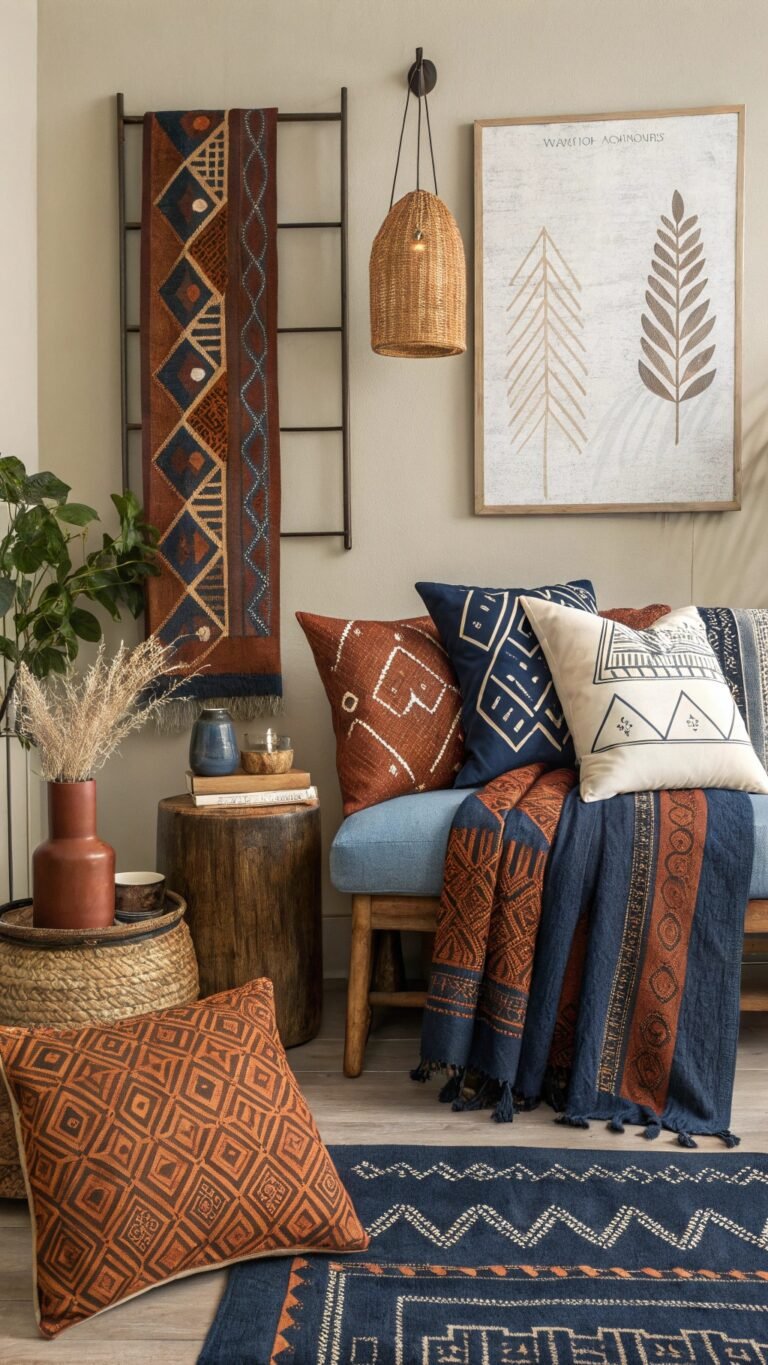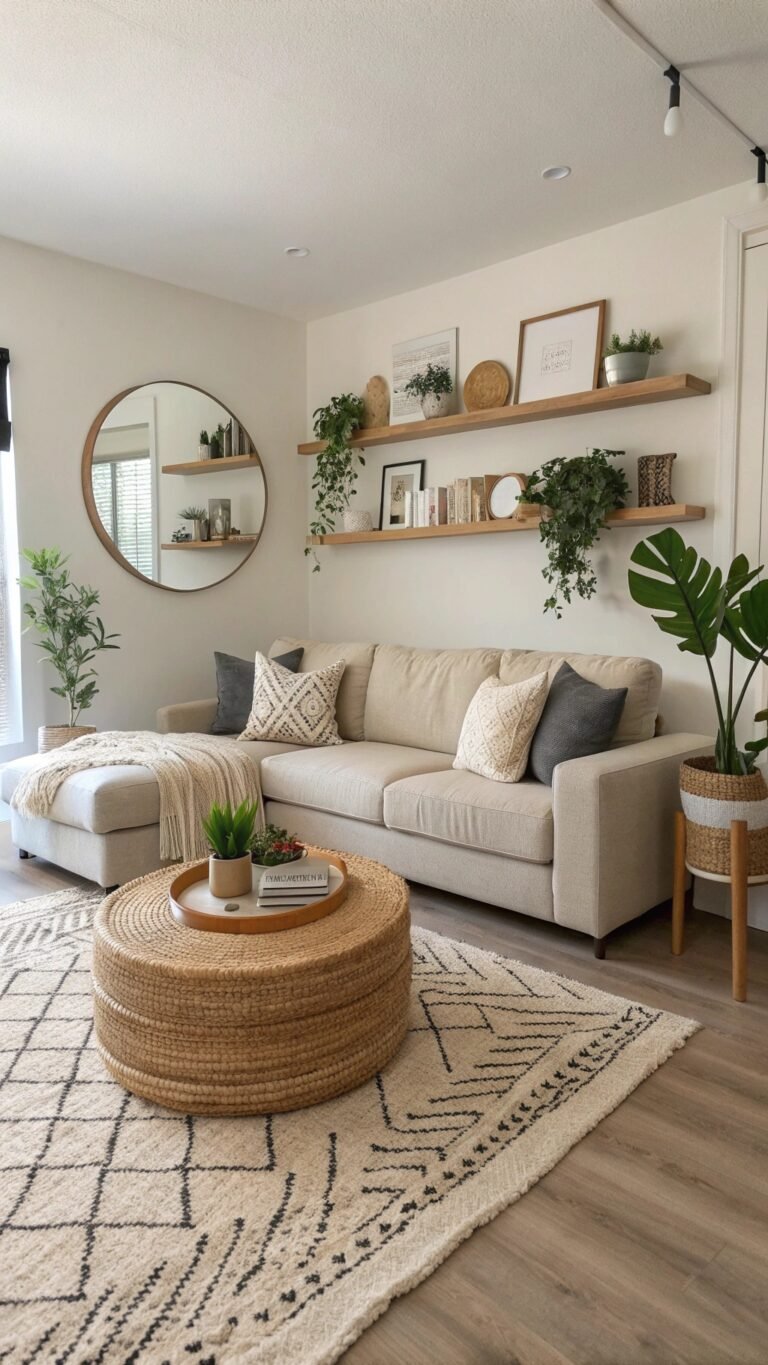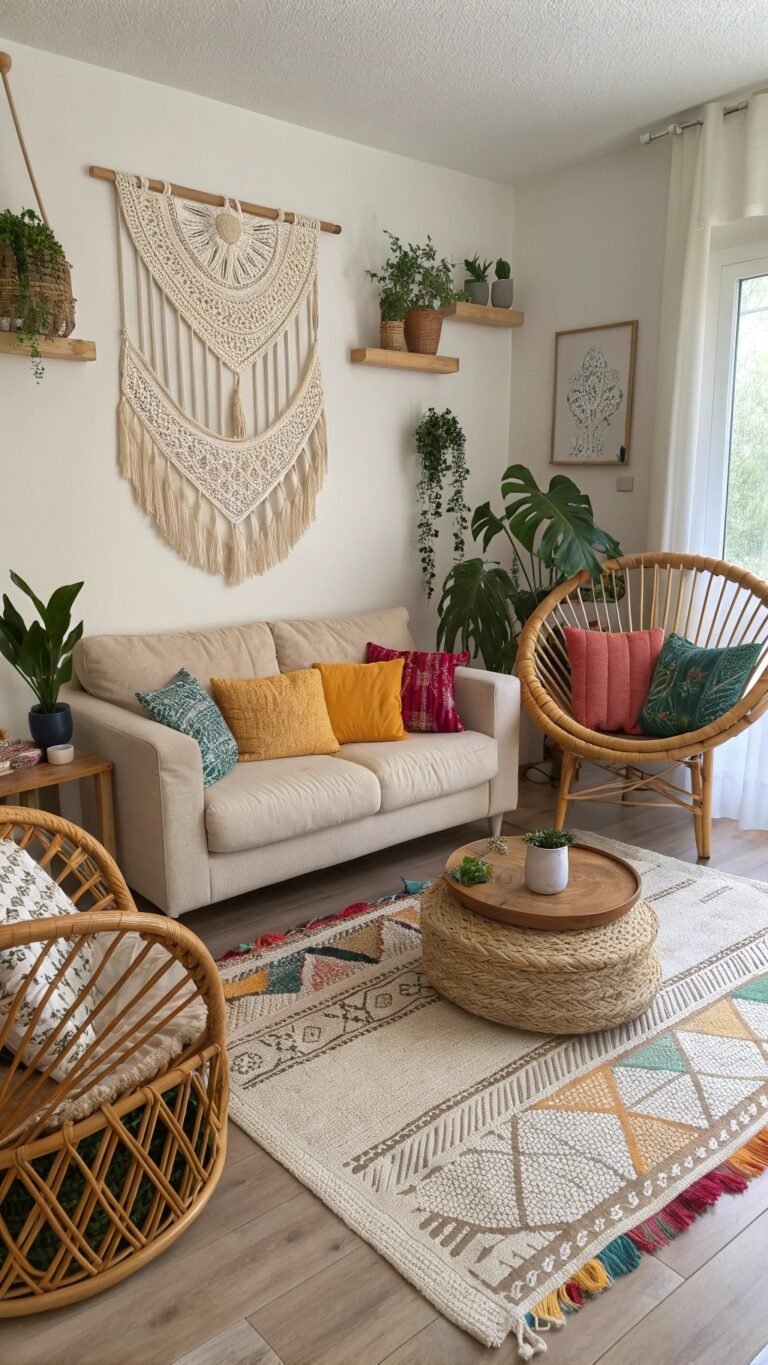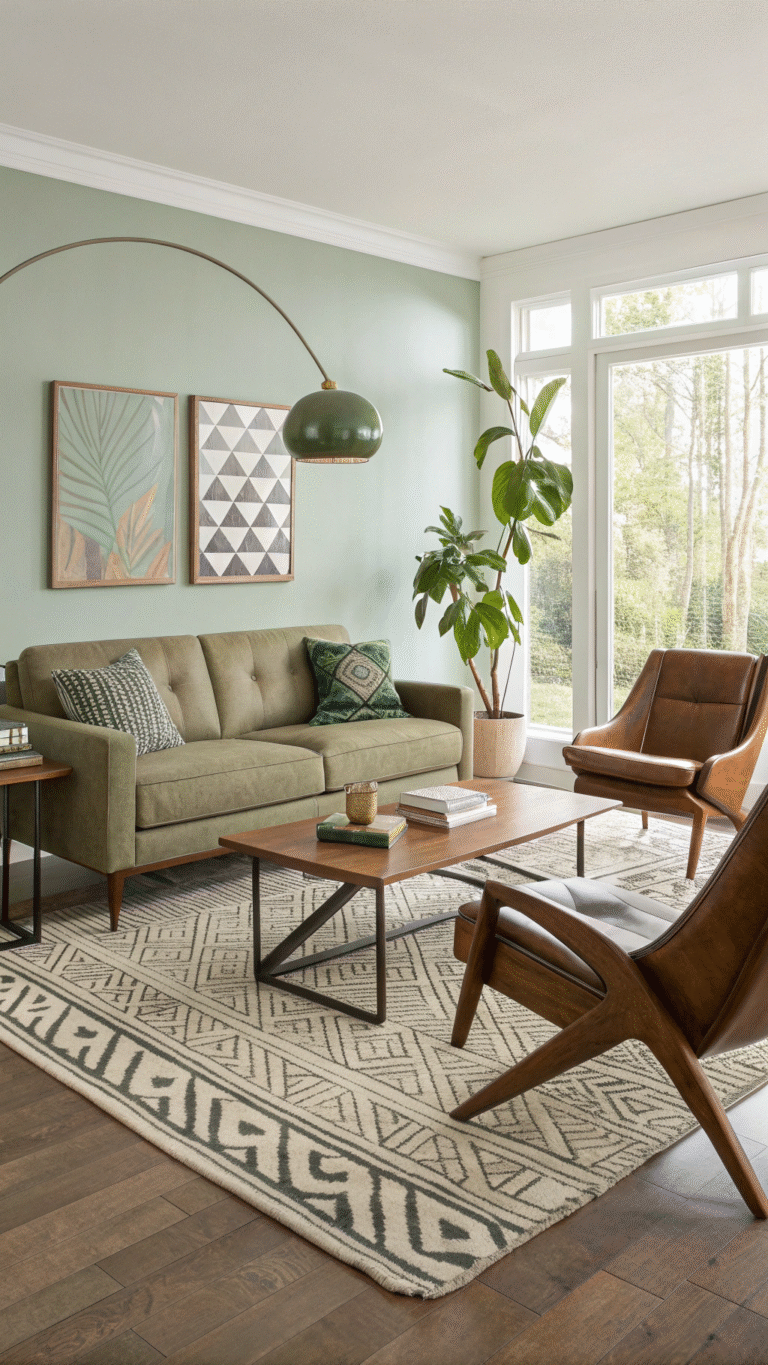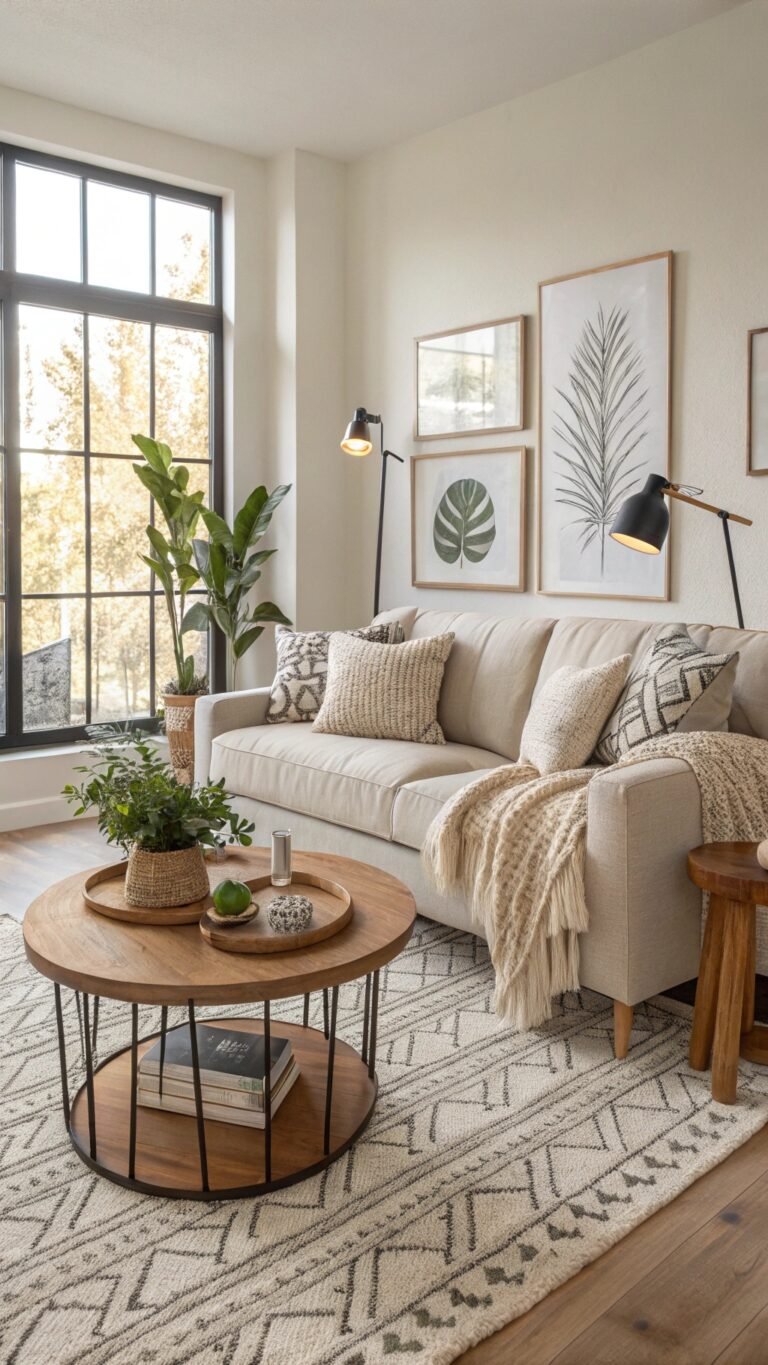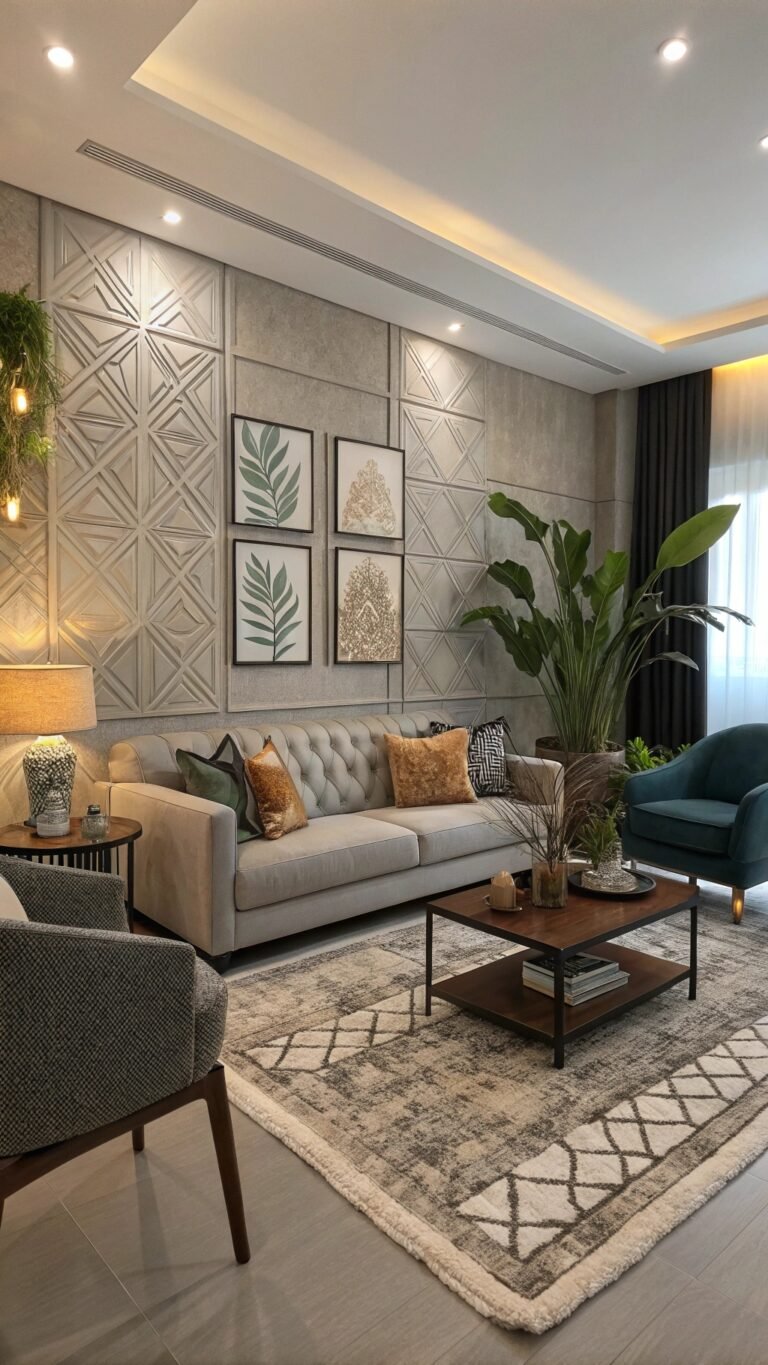Curtains Living Room: 17 Stylish Window Ideas That Transform Your Space
Curtains living room searches are booming because drapery is a fast, high-impact upgrade that changes light, scale, and mood without a remodel.
From ceiling-mounted tracks to double layers and smart motors, today’s options blend style with function. Choose one headline move, add two subtle tweaks, and your lounge will look instantly elevated.
1) Floor-to-Ceiling, Wall-to-Wall Drama
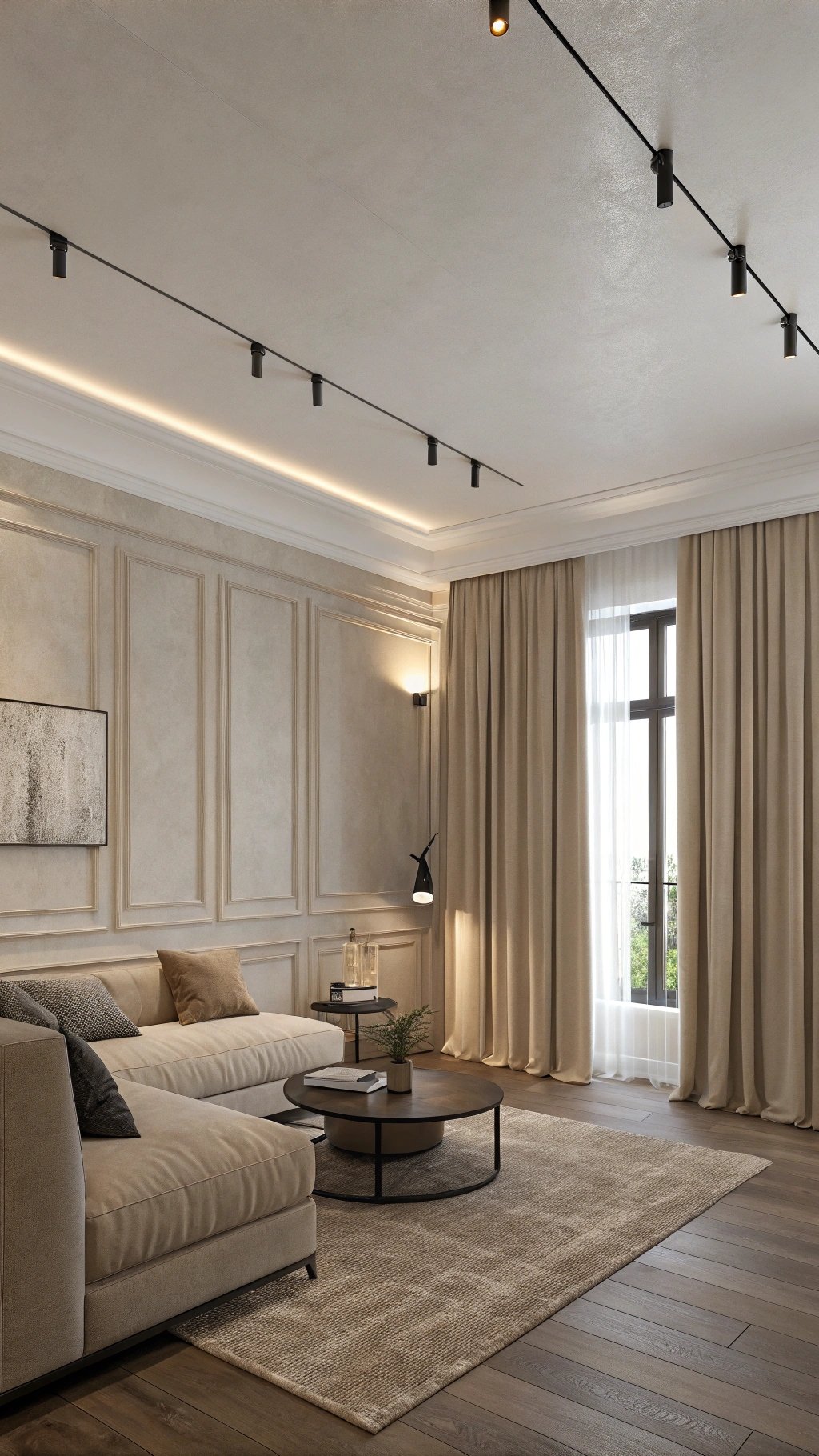
Running curtains from ceiling to floor—and ideally wall-to-wall—visually widens the room and raises the perceived ceiling.
A continuous track eliminates fussy breaks, softens acoustics, and hides off-center windows. Stick to generous fullness (at least 2× fabric) so folds read rich, not skimpy.
Neutral linen-blend panels create movement while keeping the palette calm and versatile.
What makes something unique:
Color-match the track to the ceiling and the leading edge of the panels to the wall tone for a tailored, architectural read.
Add a slim toe-kick light beneath a console to graze the drapery at night. The glow emphasizes verticality, turning the curtain wall into a subtle light installation that feels custom and expensive.
2) Sheer + Blackout Double Layer
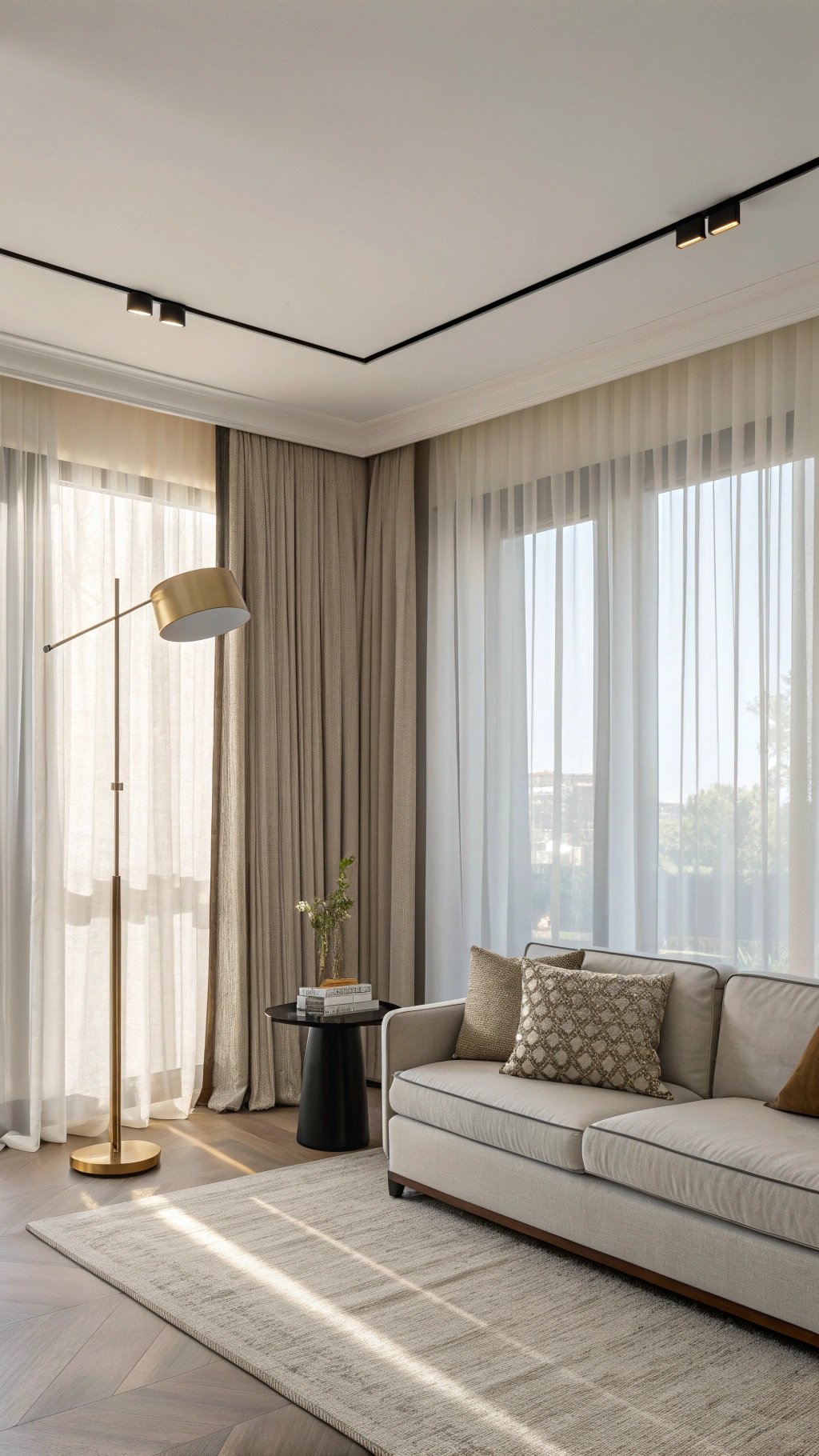
A sheer inner layer filters midday sun, while a lined blackout outer layer delivers privacy and movie-night darkness.
Layering allows flexible scenes without changing hardware. Use the sheer during the day to soften views and the blackout at night to cocoon the room. Both should kiss the floor and stack neatly to the sides.
What makes something unique:
Mount two separate tracks—one for sheer, one for blackout—so layers glide independently. Choose a slightly warmer sheer (ivory, not optic white) to flatter skin tones and interior materials.
Edge-bind the blackout with a slim grosgrain in a matching tone for tailored lines that feel couture without shouting.
3) Ripple-Fold Track for Hotel Calm
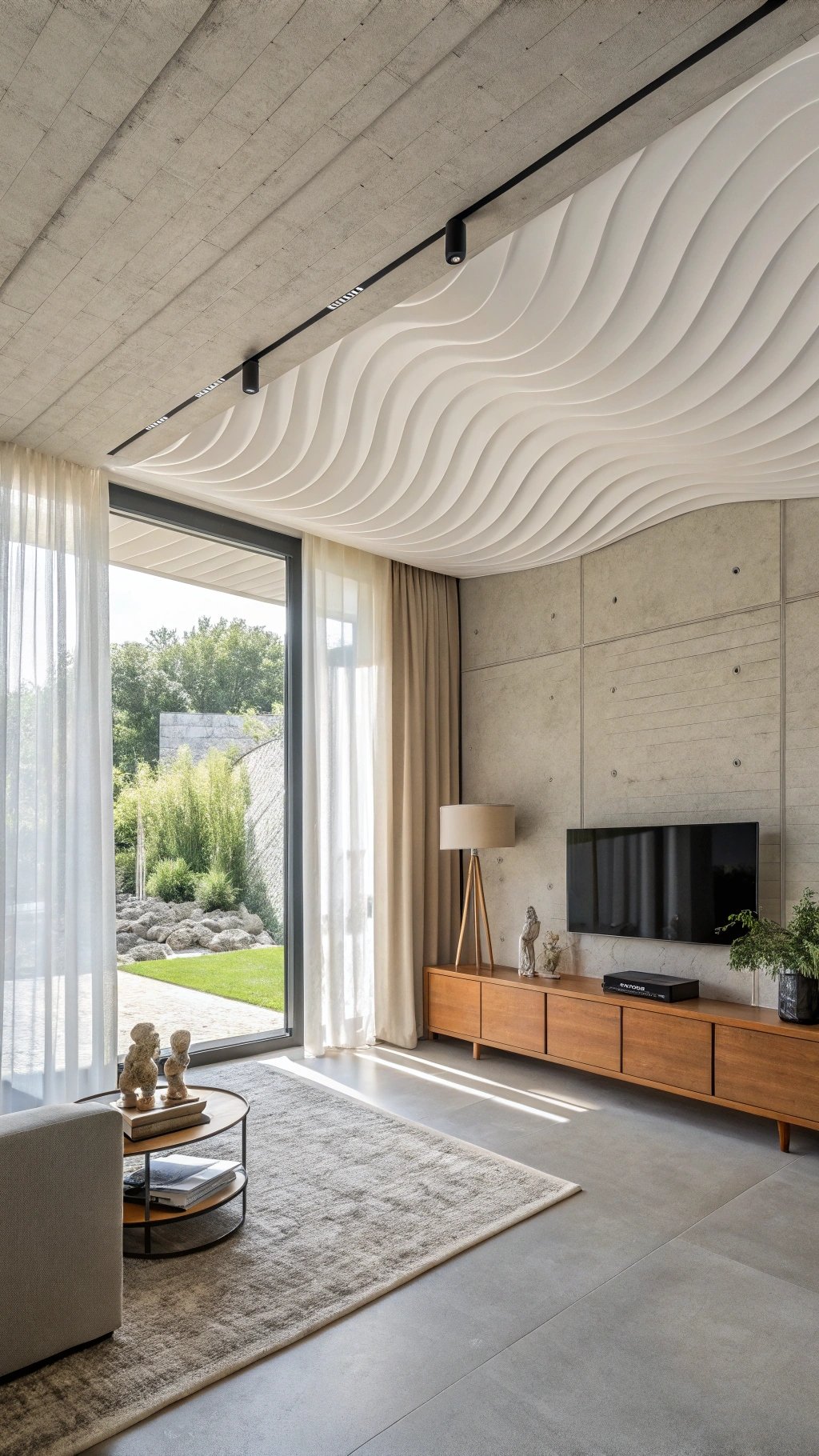
Ripple-fold (S-fold) curtains create perfectly even waves along a slim track, ideal for contemporary rooms.
The uniform spacing reads serene, photographs beautifully, and operates effortlessly. Because there’s no bulky header, the panel stacks compactly, maximizing window exposure while maintaining a crisp profile when drawn.
What makes something unique:
Specify return pieces so fabric wraps the wall and hides light gaps. Keep the hem weighted for clean verticals and choose a fabric with a soft hand, like linen-viscose or wool-blend.
The engineered rhythm feels like boutique-hotel detailing and requires less fuss than pleated headers day to day.
4) Tailored Pinch Pleat (Euro Pleat)
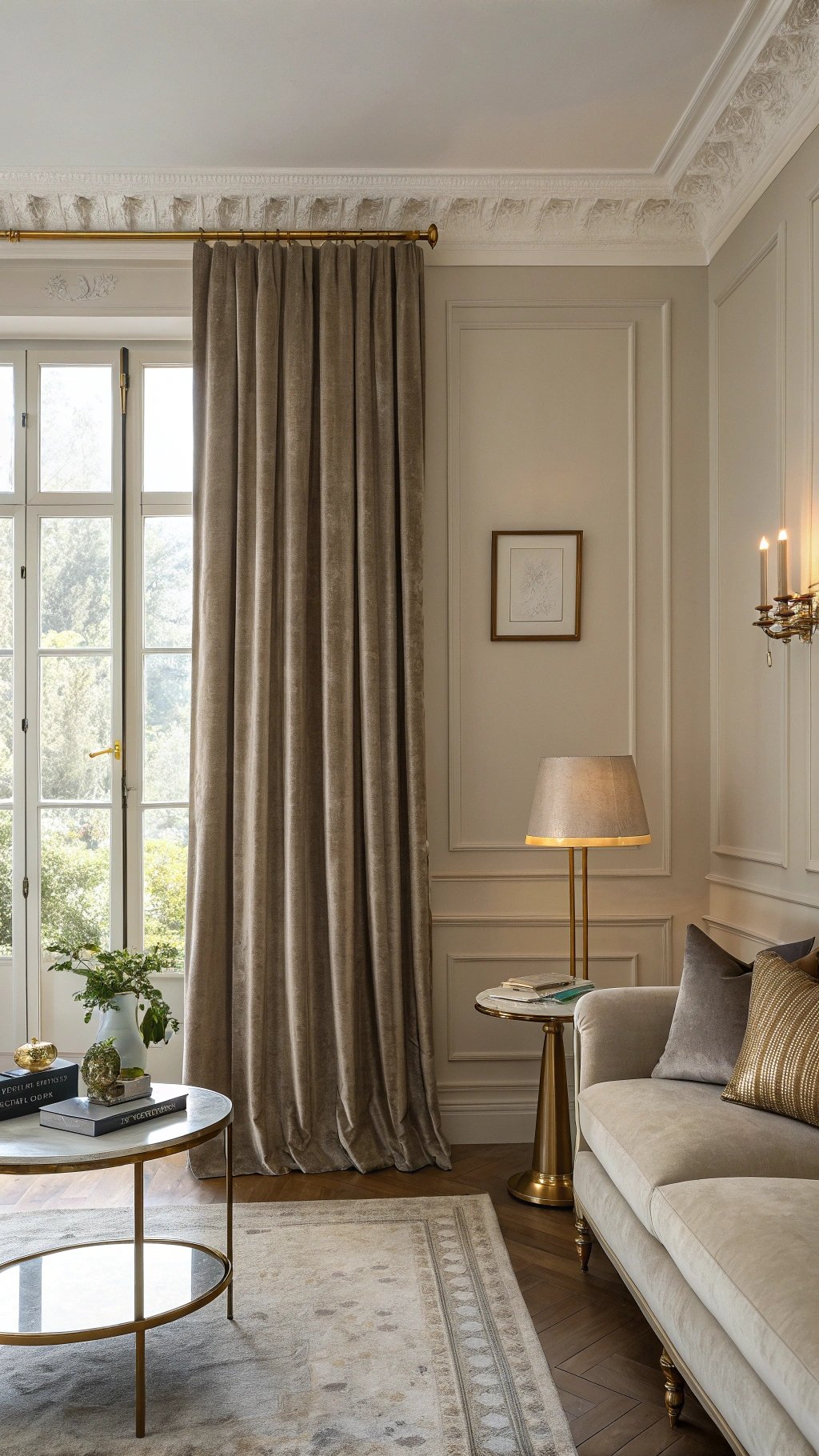
For a timeless, upscale look, opt for triple or Euro pinch pleats. The stitched header creates elegant stack-back folds that feel structured and formal without being fussy.
This header style pairs well with heavier fabrics—velvet, wool, or lined linen—and makes even simple rods look custom.
What makes something unique:
Use hidden rings with drapery hooks for whisper-quiet movement and a cleaner top line. Match the pleat spacing to architectural elements (moldings, window mullions) so the rhythm feels intentional.
Finish with a micro-contrast leading edge—two shades darker than the panel—for a subtle frame that sharpens the silhouette.
5) Roman Shades + Stationary Side Panels
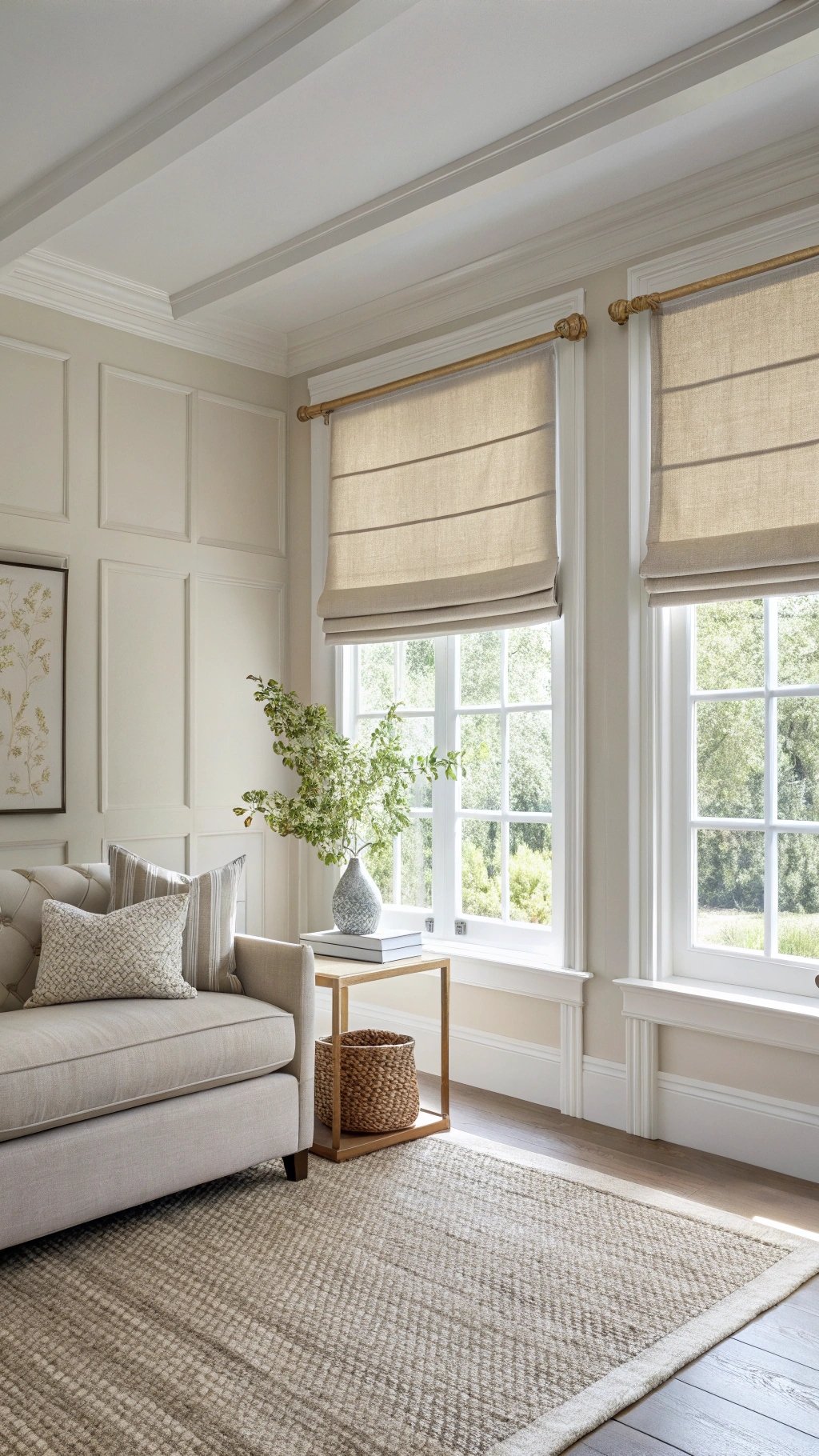
When furniture or radiators limit full-width drapery, combine inside-mounted Roman shades for function with slim stationary panels for polish.
The shades handle light and privacy; the side panels add softness and vertical presence. This hybrid is great for bays, small rooms, or asymmetrical windows.
What makes something unique:
Choose a textured solid for the panels and a subtle stripe or herringbone for the Romans in the same palette for depth without pattern clash.
Keep panel return minimal so they frame—not crowd—the shades. The look reads balanced and intentional, solving tricky layouts with tailored calm.
6) Bold Pattern as the Focal Point
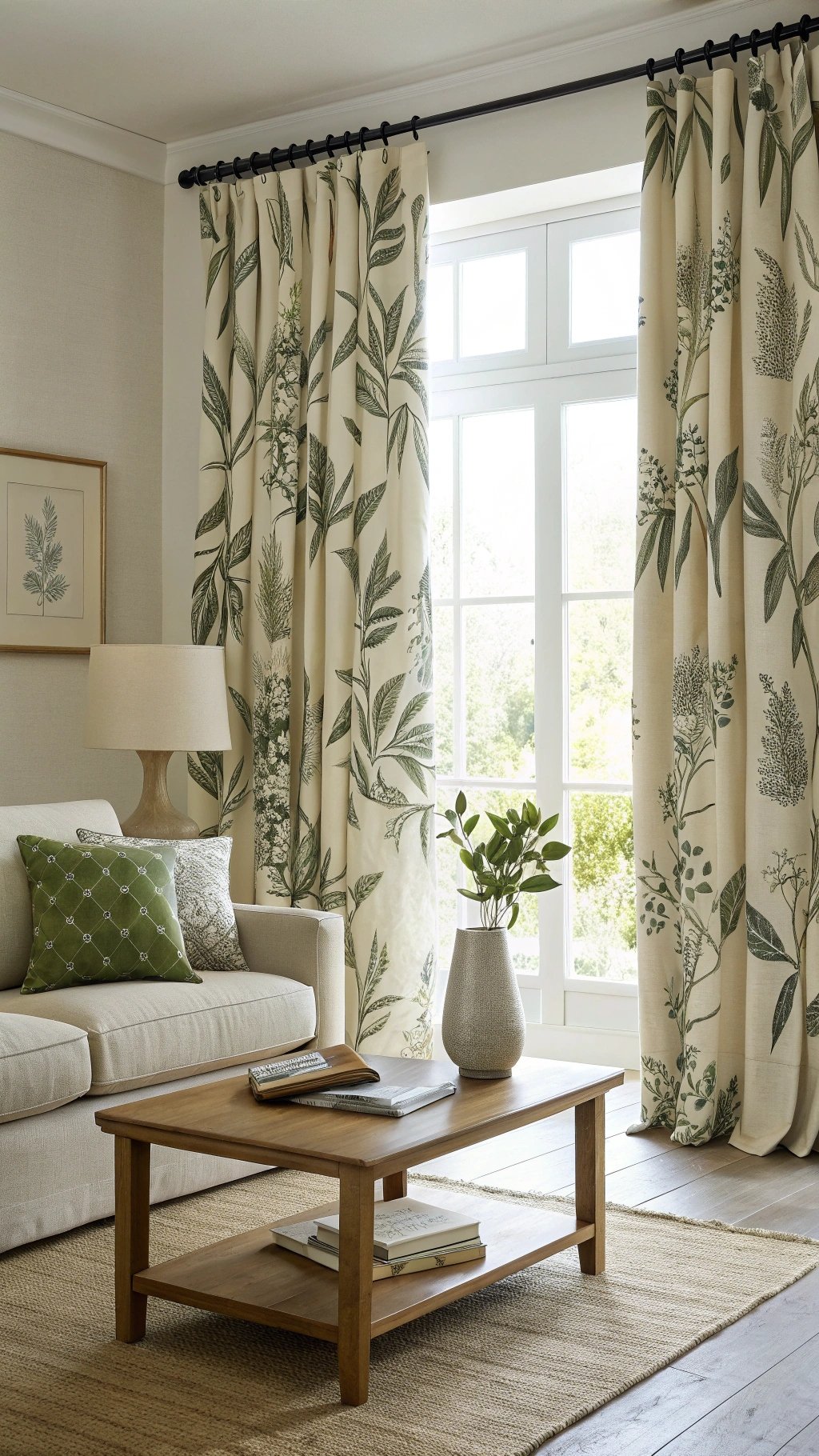
Let curtains carry the room’s personality with a large-scale print—abstract botanicals, painterly stripes, or heritage motifs.
Keep furniture and rug quieter so the pattern reads as a statement wall that moves. Fullness and lining are crucial so the print doesn’t distort or look thin against the light.
What makes something unique:
Color-discipline the scheme: pull just two accent tones from the print into pillows or a ceramic lamp and leave everything else neutral.
Pattern placement matters—center a hero motif at the leading edges for symmetry. The result feels editorial, not busy, and photographs like a collected, curated space.
7) Tone-on-Tone Color Drench
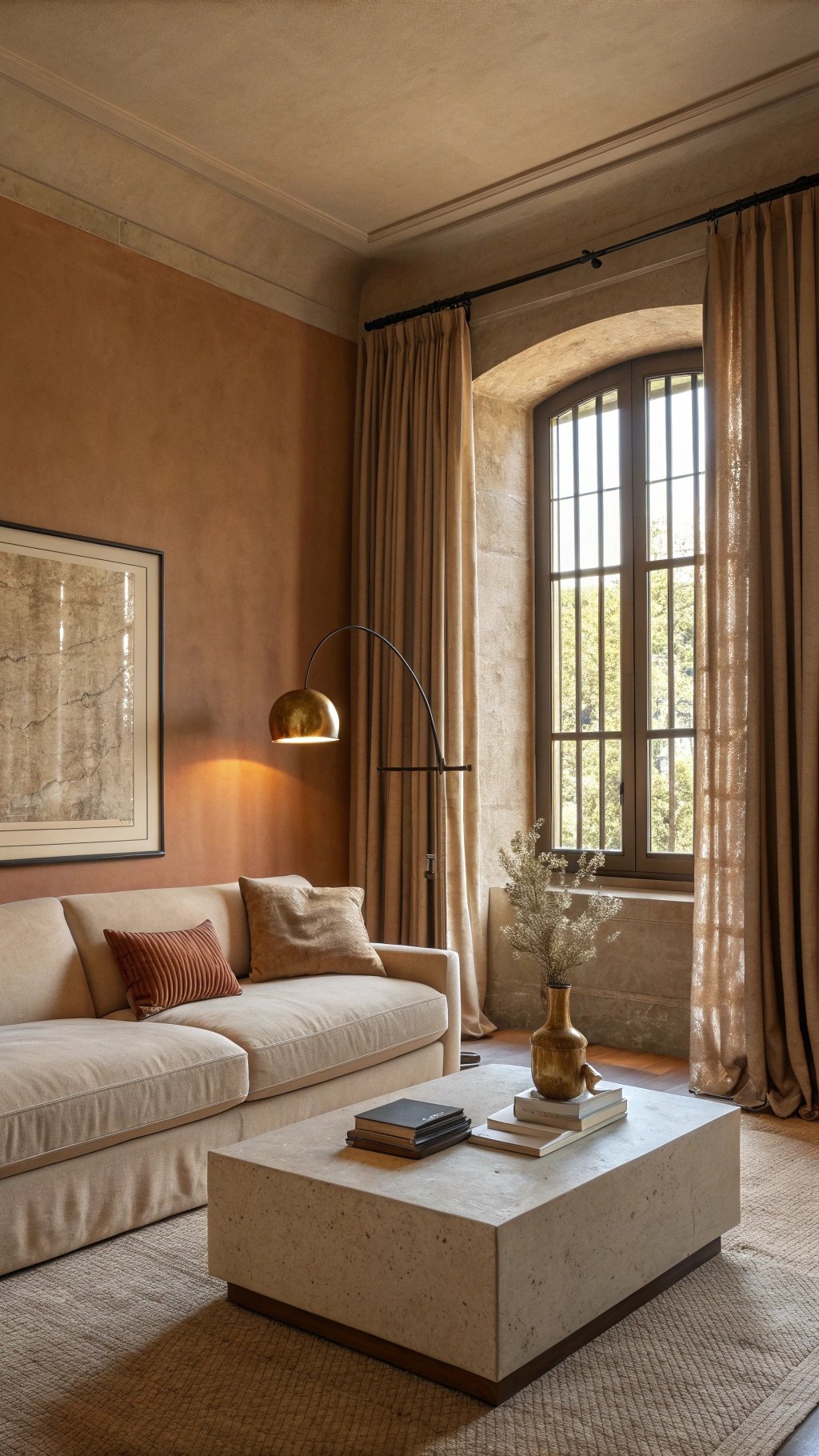
Wrap walls, curtains, and even the sofa in one sophisticated hue—mushroom, olive gray, or muted clay—for a cocooned, gallery-calm effect.
The low-contrast envelope makes rooms feel more tailored and larger, as edges visually melt. Choose a fabric slightly darker than the wall for depth.
What makes something unique:
Play with sheen: matte walls, soft-lustre curtains, and a velvety cushion. Add one pale stone element (travertine table) to keep the palette lifted, and a single brass detail for glow. The tonal discipline reads luxurious without relying on pattern or loud color.
8) Linen Sheers for Light Play
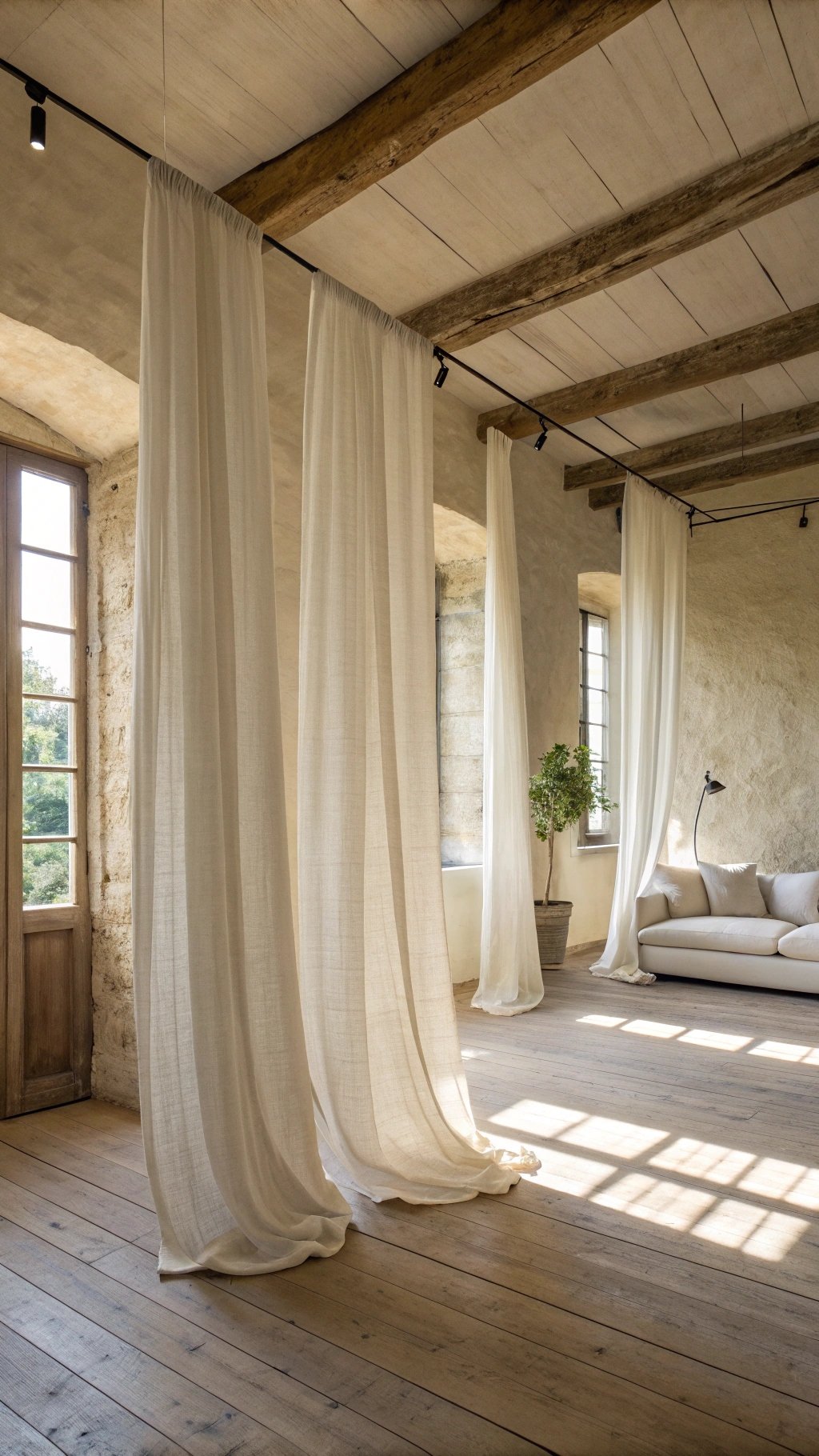
Airy linen sheers turn sunlight into texture. They blur outside views just enough for daytime privacy while keeping the room bright.
Use generous puddling (1–2 cm) for a relaxed look or a crisp kiss to the floor for minimalists. Sheers pair beautifully with natural materials like oak and plaster.
What makes something unique:
Choose woven slubbed linen with irregular threads to catch light and cast subtle shadows on the floor. Mount the track slightly wider than the window so panels stack off-glass.
The constantly shifting light patterns add quiet drama that feels spa-like from morning to evening.
9) Velvet for Luxe Acoustics
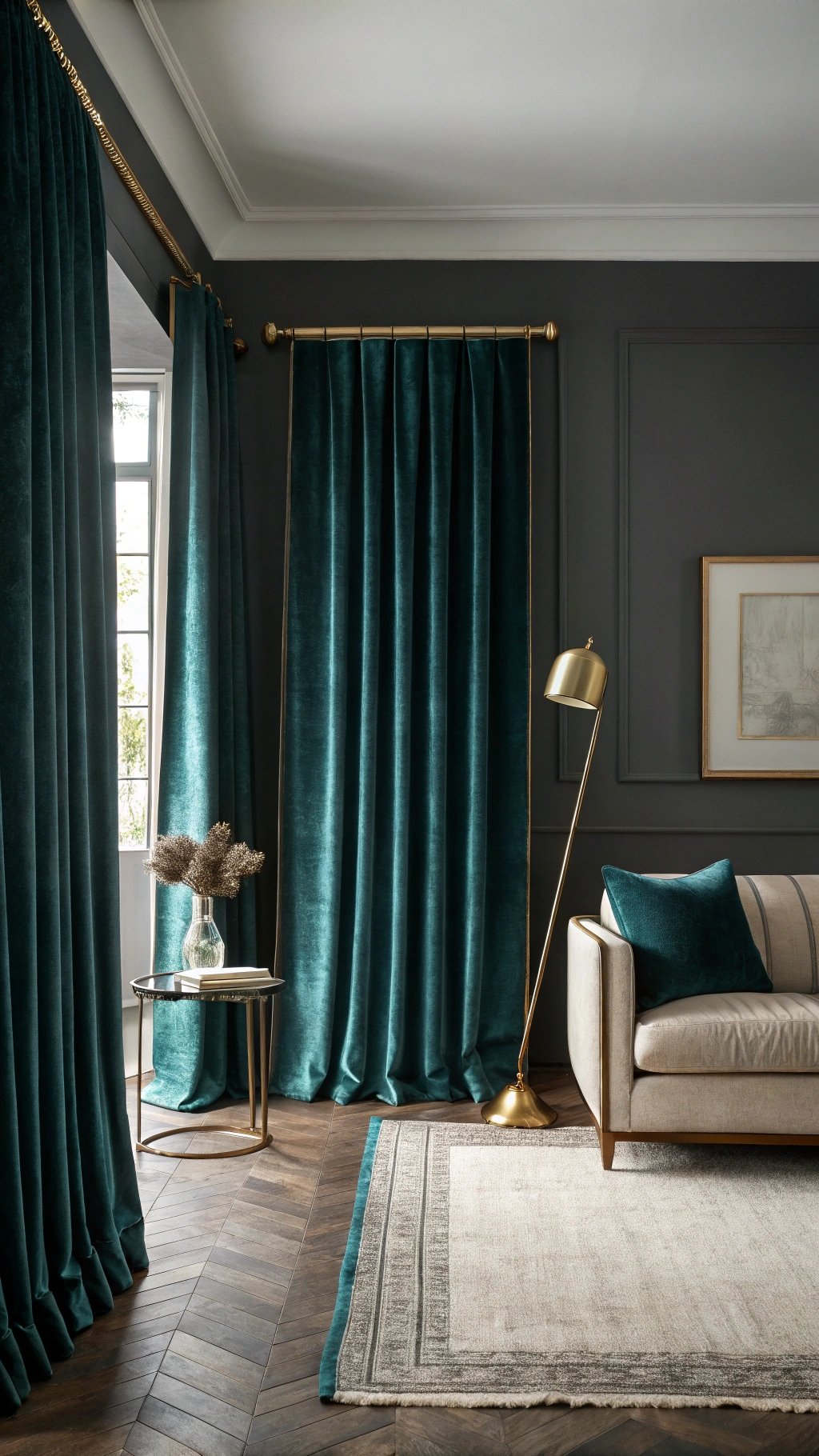
Velvet curtains absorb sound and light, perfect for echo-prone rooms or media setups. The pile reflects a soft sheen that looks rich under evening light.
Pair with a wool rug and upholstered seating for a cocooned, cinema-worthy living room that still feels sophisticated during the day.
What makes something unique:
Pick cotton or mohair velvet with a heavy sateen lining to prevent glow-through and keep folds crisp.
A slim contrast cord on the leading edge outlines the panels like finely tailored clothing. With dimmers set low, the velvet reads as deep color rather than shiny fabric—true quiet luxury.
10) Woven Naturals + Drapery Layer
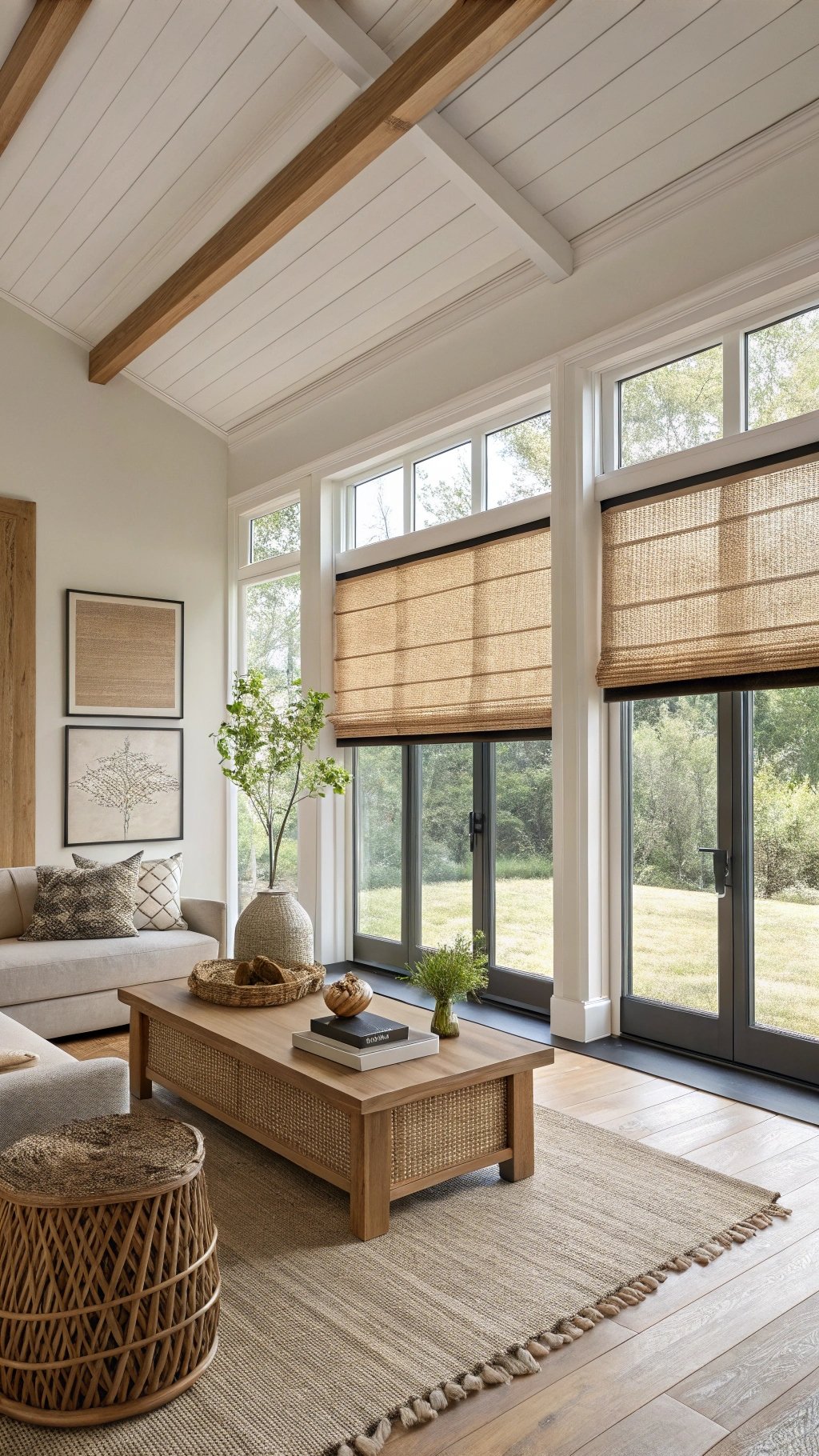
Layer natural shades—bamboo, grasscloth, or woven wood—with soft side panels. The shades handle glare and texture; the panels add height and refinement.
This mix bridges coastal and city sensibilities, offering an organic counterpoint to stone and metal.
What makes something unique:
Keep the drapery tone a shade lighter than the woven material for contrast that still reads cohesive.
Use edge binding on the shade to prevent fraying and repeat that binding color on the drapery leading edge. The dialogue of rough and refined feels intentional and tactile.
11) Arches, Bays, and Tricky Windows Solved
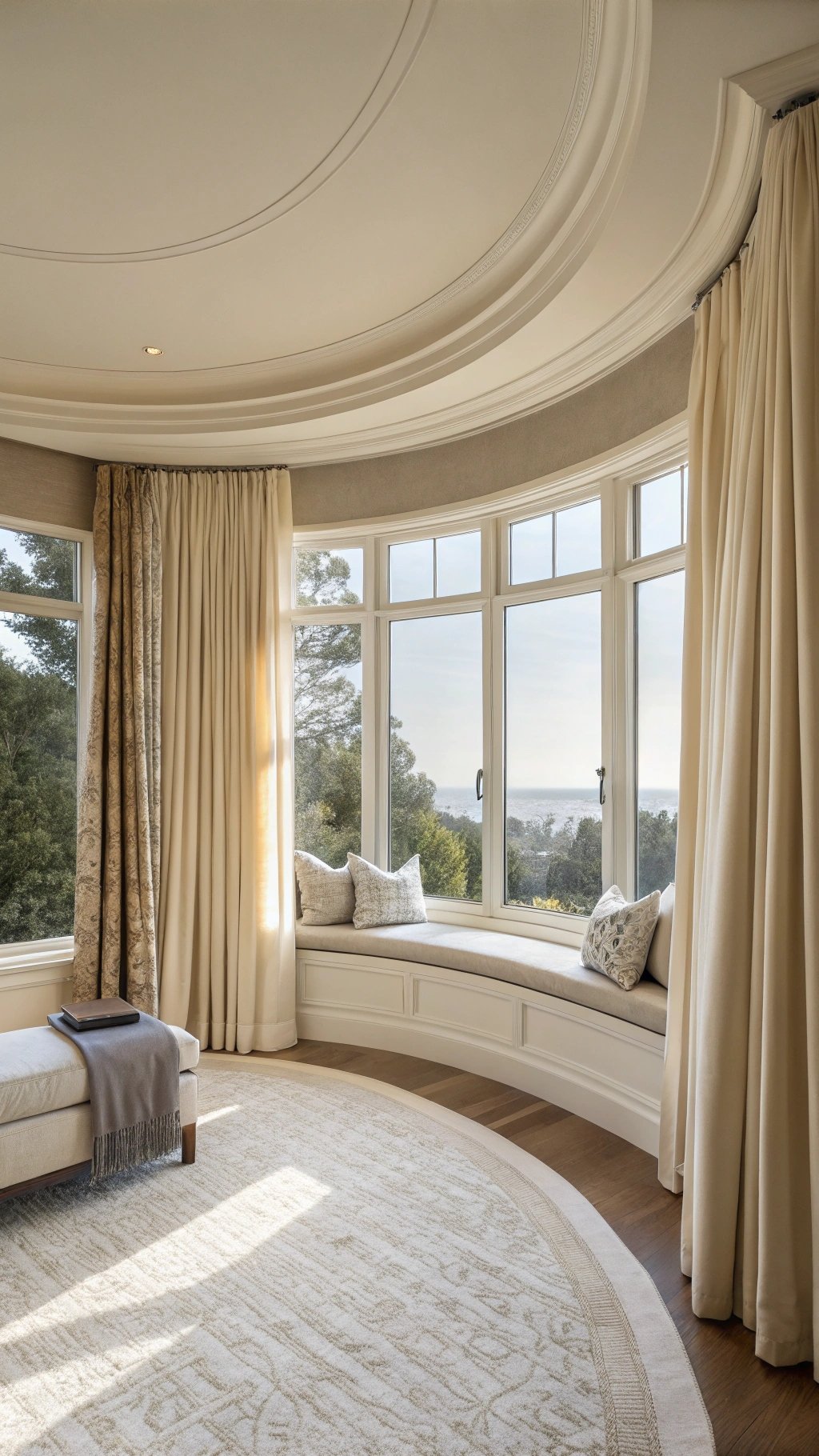
Odd shapes deserve graceful solutions. For bays, run a custom-bent track that follows the curve for smooth stacking.
For arches, mount a concealed straight track at the ceiling plane to protect the shape while delivering full coverage. Keep panel fullness consistent across segments for a continuous read.
What makes something unique:
Align pleat or ripple spacing with mullions so lines feel choreographed. Use returns that hug the wall to eliminate light leaks.
When geometry and fabric cooperate, the window becomes a feature, not a compromise, and the living room gains quiet sophistication.
12) Hardware That Disappears (or Performs)
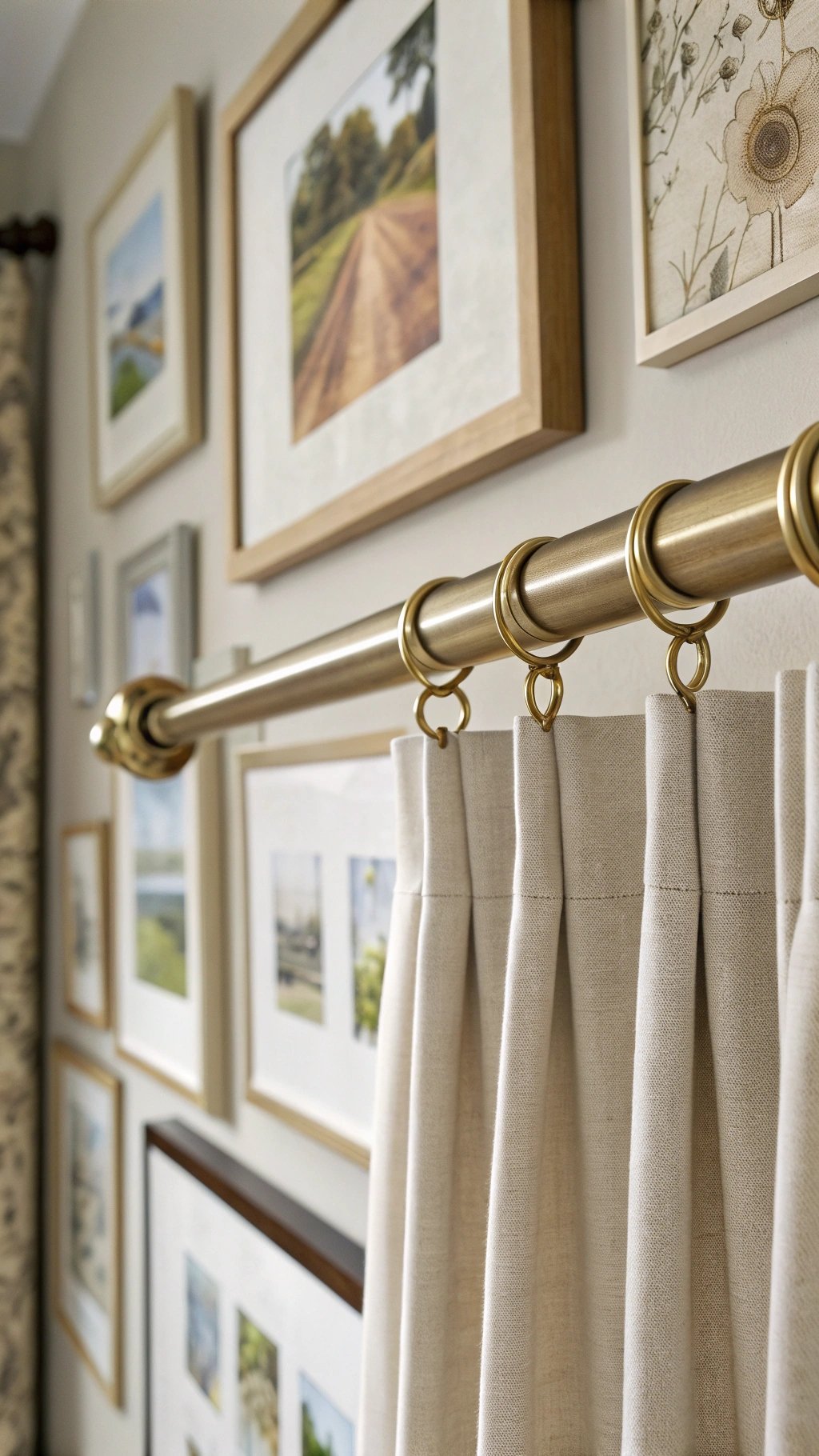
Curtain hardware is either invisible or jewelry—decide which. A recessed ceiling track disappears for a seamless look.
Alternatively, a slender brass or blackened-steel rod with minimal finials adds a line of elegance. Rings with quiet glides make daily use feel premium.
What makes something unique:
Echo hardware finish in two other small places—a frame and a lamp finial—for cohesion. If choosing visible rods, install center brackets to prevent sag and set projection so panels clear handles. The right hardware choice elevates everyday movement into a tactile pleasure.
13) Smart Motorized Curtains
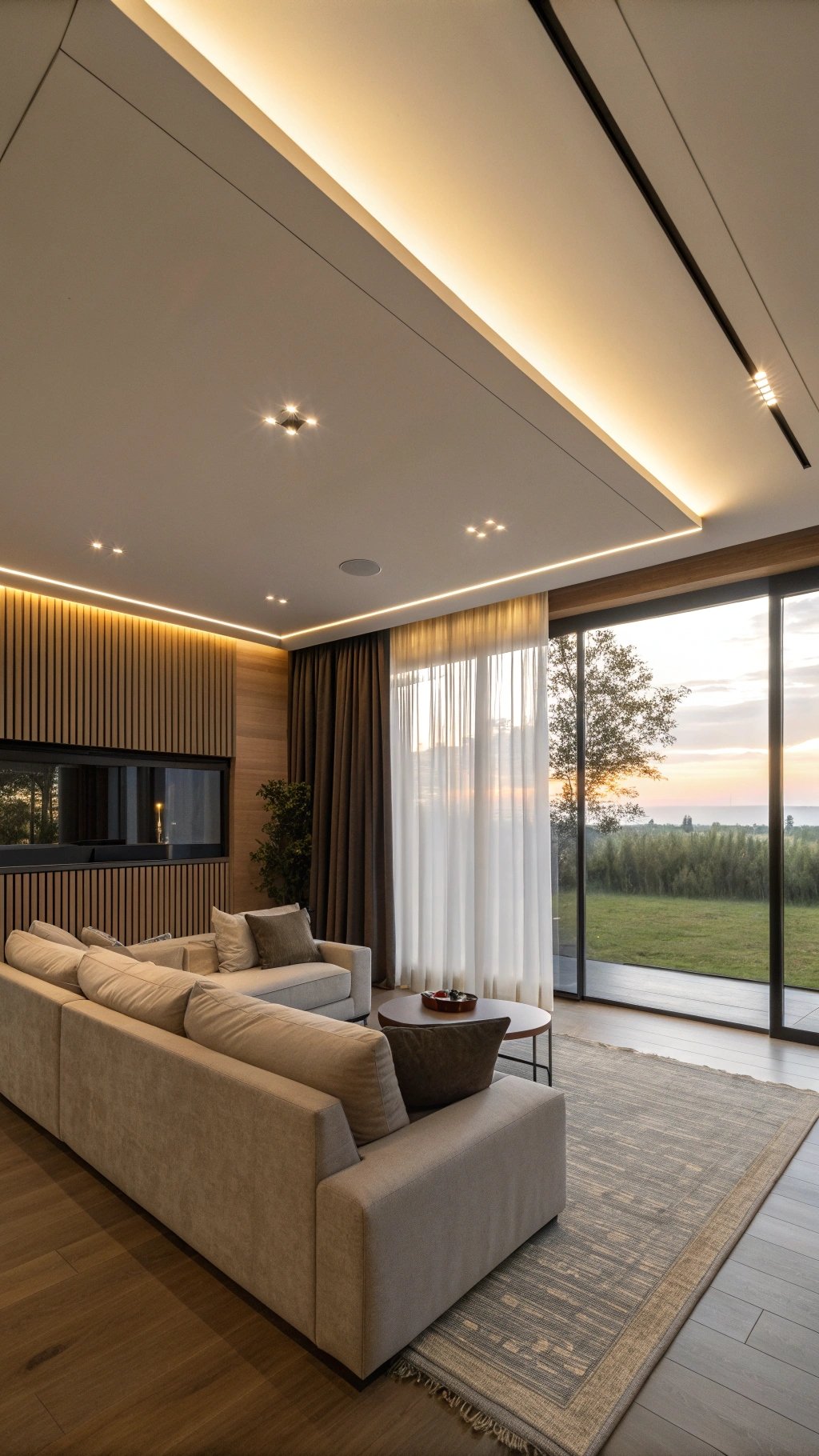
Motorized tracks bring quiet luxury and better light discipline. Schedule sheers to open with sunrise and blackouts to close at dusk.
Hands-free operation protects delicate fabrics from oils and keeps folds pristine. Ideal for tall windows or wide spans that are heavy to draw.
What makes something unique:
Choose low-profile motors concealed behind a pelmet, and integrate with dimmer scenes—Morning, Movie, Night. Use soft-start/soft-stop to preserve header stitching.
The choreography of fabric and light becomes part of the room’s daily ritual, blending technology into a calm, minimalist envelope.
14) Small Living Room, Big Curtain Moves
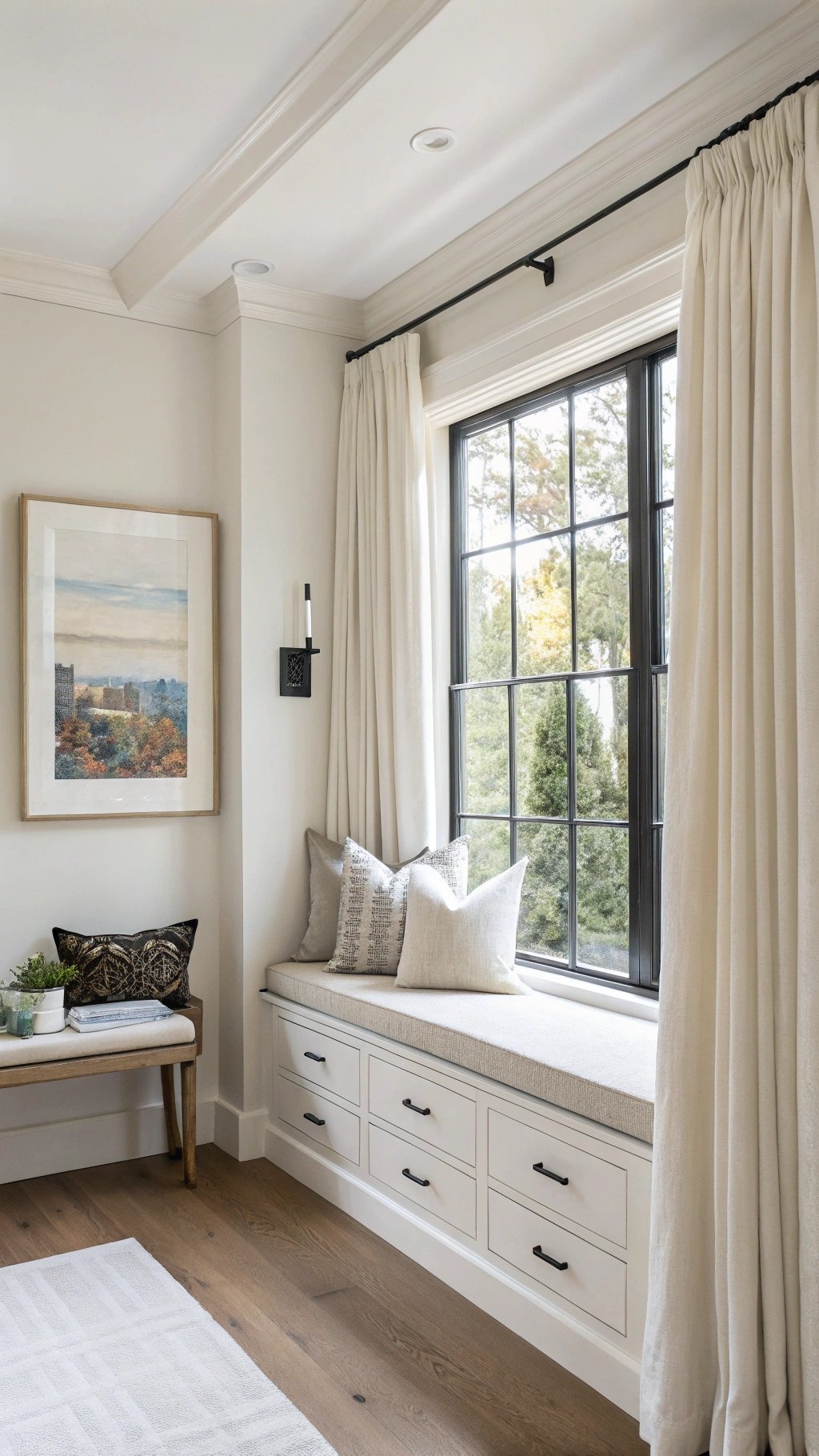
In tight spaces, mount the rod higher and wider than the window so panels stack off-glass. Use slim rods and lightweight fabrics to avoid bulk near corners and door swings.
A single large artwork between windows keeps the sightline quiet and lets the drapery provide softness.
What makes something unique:
Specify 1.5×–2× fullness to keep folds modest and traffic-friendly. Add a shallow window bench with drawers below the curtain line to reclaim storage without stealing circulation.
The room reads taller, brighter, and more intentional—proof that scale tricks are the best budget luxury.
15) Seasonal Curtain Strategy
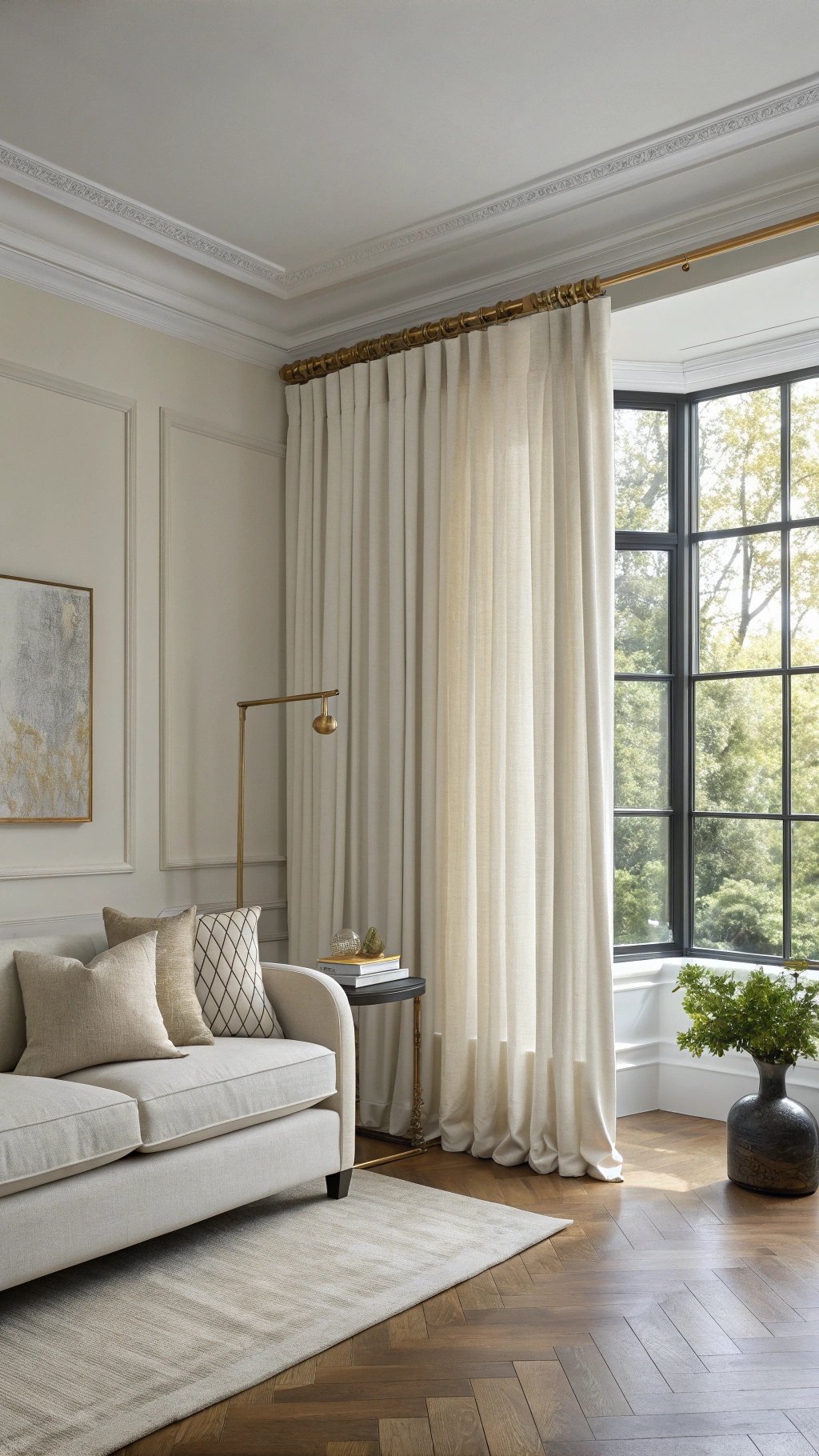
Swap panels seasonally to change mood without new furniture. Linen sheers or lightweight cotton for spring–summer; lined wool or velvet for fall–winter.
Keep rods/tracks constant and store off-season panels rolled on tubes to avoid creases. The living room’s palette adapts with the light and weather.
What makes something unique:
Repeat one accent tone across seasons to maintain brand consistency—perhaps warm brass hardware or a sandstone table.
Use interchangeable tie-backs or magnetic catches matching each fabric’s vibe. The ritual makes the room feel fresh twice a year and extends fabric life through rest.
16) Eco-Smart Fabrics and Finishes
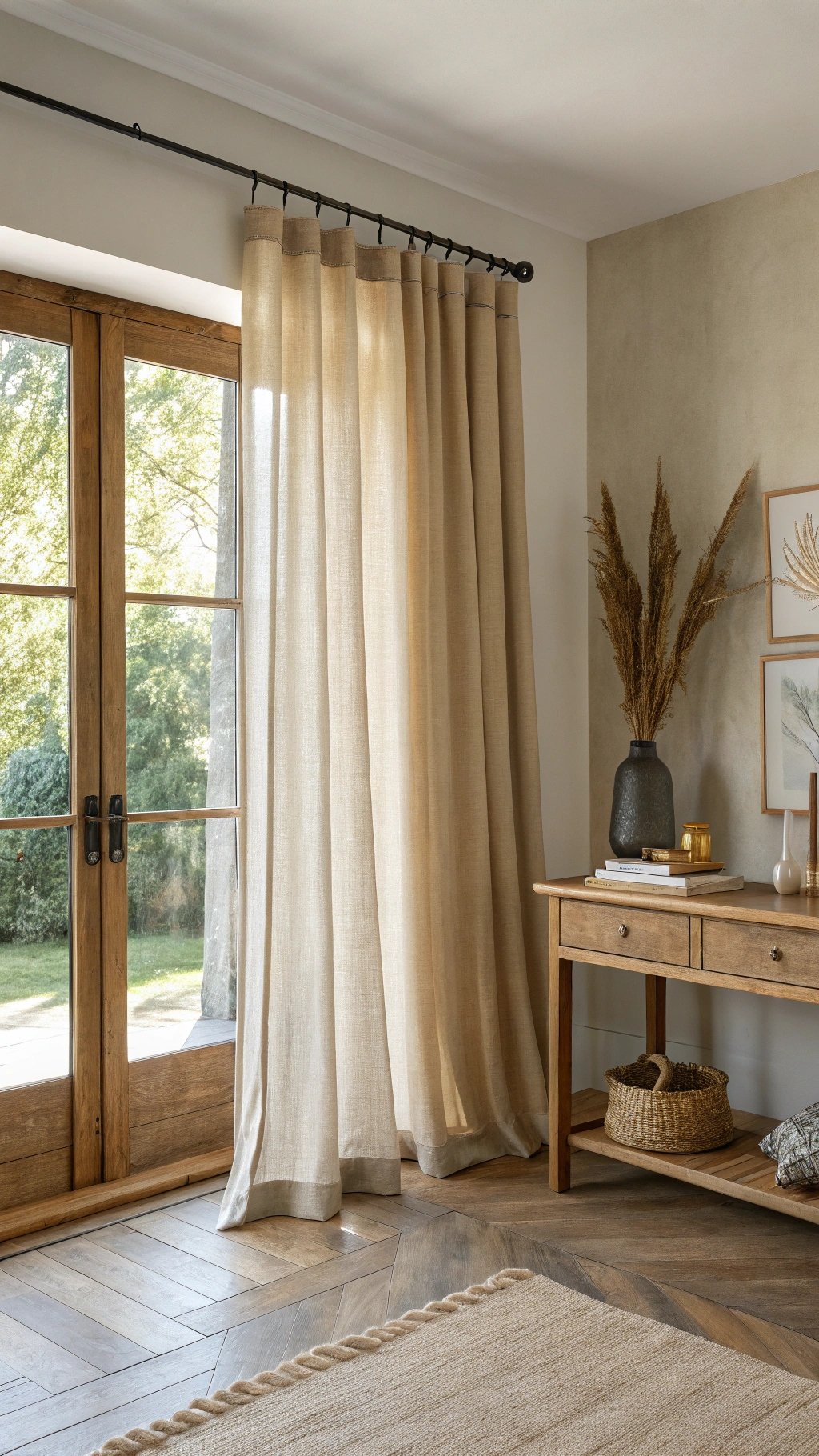
Choose OEKO-TEX–certified linens, recycled polyester sheers, or organic cotton blends. Low-VOC finishes on rods and tracks protect indoor air.
Durable, cleanable textiles reduce replacement cycles. Sustainable choices can still look luxe when texture and tailoring lead.
What makes something unique:
Let sustainability show: a tag noting recycled content on the panel hem (hidden in use), solid-brass hardware designed to patina, and a maintenance kit (gentle steamer, lint brush) stored in the console. The story of materials becomes part of the decor—and the room ages gracefully.
17) Styling, Steam, and Everyday Care
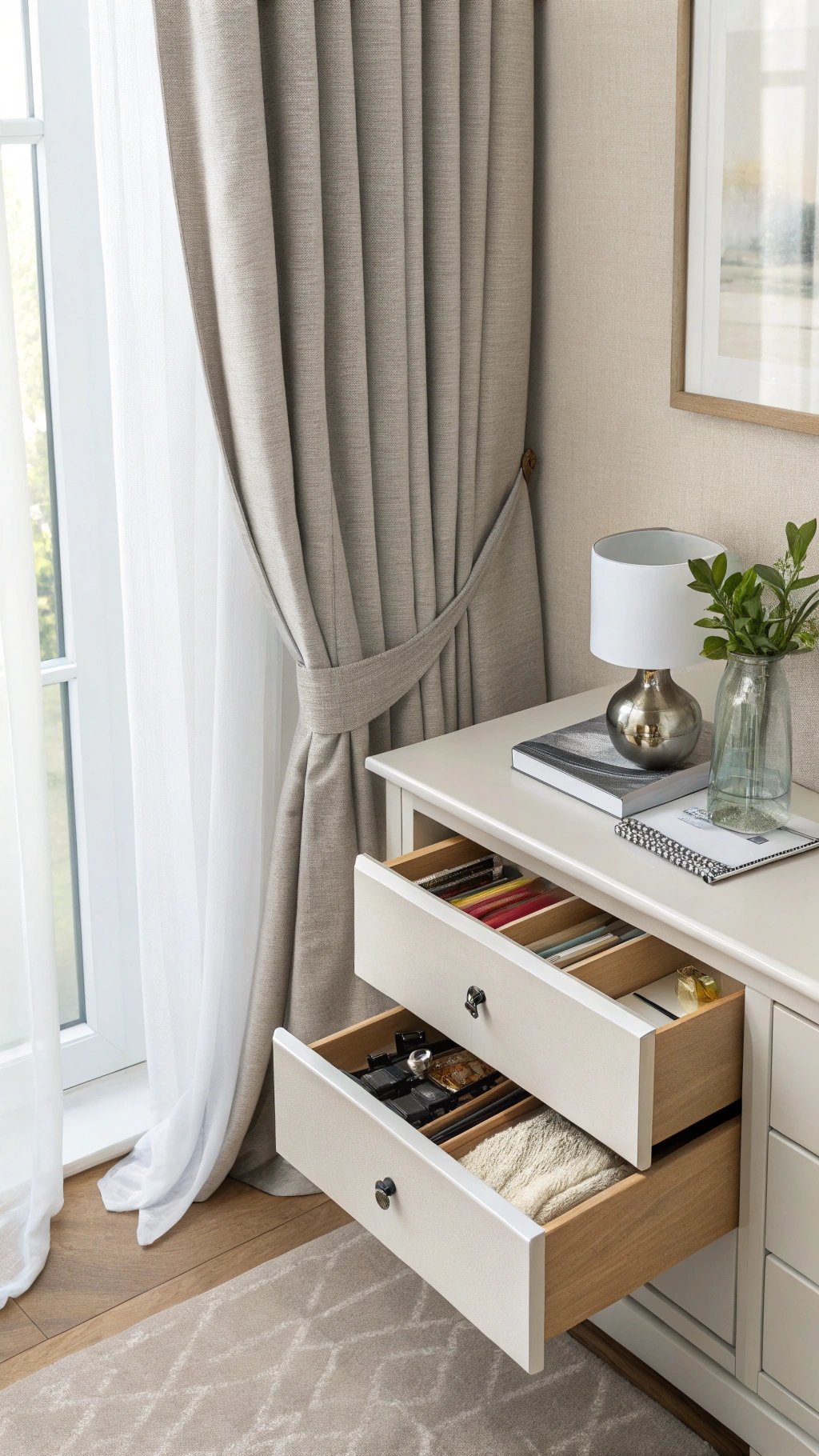
The best curtains look effortless because maintenance is built in. Hang panels immediately after light steaming; “train” folds by banding them loosely for 24–48 hours.
Dust the header and track monthly, and vacuum hems with a brush attachment to keep edges crisp. Small habits protect drape and line.
What makes something unique:
Create a hidden care station: a narrow drawer with labeled bands, fabric clips, and a compact steamer. Add a note with your preferred settings and panel fabric.
Treating curtain care like part of the room’s design keeps everything camera-ready with minimal weekly effort.
Quick Tips to Nail Curtains in the Living Room
Mount high and wide for taller, wider-looking windows.
Aim for at least 2× fullness for richness and better light control.
Pick one hardware finish and repeat it in two small accents for cohesion.

